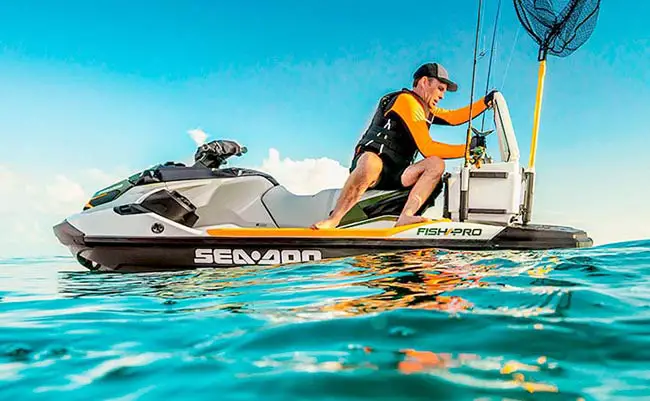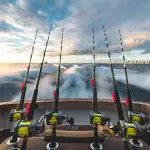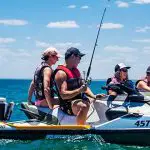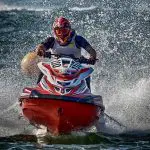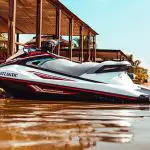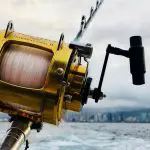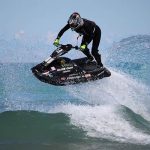Fishing is a sport like no other, and fishing from a jet ski is a thrill like no other. Ocean fishing in particular is a true challenge: testing your mettle against a wild, living beast, while also testing yourself against the natural elements of the ocean. It can be exciting, adventurous, and seriously fun.
It can also be dangerous. Fishing from a jet ski presents unique challenges that no other fishing experience provides. Not only do you need to be an excellent fisherman or woman, but you also need to be an excellent jet ski rider, navigator, weatherperson, diver, and swimmer.
Videos like this one demonstrate the importance of following strict safety protocols when fishing from a jet ski in the ocean. We’ve compiled a list of safety tips that can help you prepare for your next ocean fishing adventure.
Contents
Basic Jet Ski Safety
1. Carry required safety equipment
- A passive ventilation system
- An approved sound-signaling device
- Vessel registration
- Life jackets. One for each rider, and the person being towed, if applicable
- A fire extinguisher (Coast Guard-approved B-1)
- A kill-switch lanyard attached to the vehicle operator
- Easily visible registration numbers, letters, etc.
- A backfire flame arrestor
2. Carry additional safety gear
In addition to the required gear, these things are important to have in case of an emergency.
- A skier-down flag, if towing a skier
- Sunscreen
- A bilge pump (hand-operated is fine)
- Daytime distress signals such as flares, mirrors, or an orange flag
- VHF radio
- Cell phone
- A basic first-aid kit
- EPIRB or PLB
- A well-sized anchor and enough anchor line
Not only should these things be on the jet ski, but they should also be maintained so that they are not broken or unusable when they are needed.
That means checking when flares expire and replacing them before they do.
It means charging your cell phone before you leave the house and making sure the battery on your VHF is fully charged too.
It means periodically going through your first-aid kit and replacing things like sunscreen and burn ointment if they are out of date.
Jet Ski Fishing Safety
Fishing from a jet ski is perfectly safe as long as you know what you’re doing and follow smart, responsibly safety procedures. Here are some of the things you should always do when heading out for a jet ski fishing adventure.
Choose the Right Jet Ski
Not every jet ski is right for fishing. Take the time to research the available options and find the PWC that will give you the best fishing experience.

A fishing jet ski should be stable, have great fuel economy, and have ample storage for your fishing gear.
Each major PWC manufacturer makes a watercraft specifically for fishing. The Sea-Doo Fish Pro is considered the best jet ski on the market for fishing. It has tons of features and accessories, including a fish finder and trolling mode.
Sea-Doo Fish Pro
The Sea-Doo Fish Pro was made for fishing. So it’s not surprising that it’s ranked the best jet ski for fishing.
It has a deep hull that makes for great ocean handling, as well as an extended read platform for additional fishing space, tons of cooler storage, and space for rods and tackle.
Kawasaki Ultra LX
The second-highest ranked jet ski for fishing, the Kawasaki Ultra LX, has 65 gallons of storage, is fuel-efficient, and has multiple storage accessories which would benefit your fishing experience.
Yamaha FX Cruiser HO
Our third favorite is the Yamaha FX Cruiser HO. It has 44 gallons of storage compared to the Kawasaki Ultra LX’s 65 and does not have any factory fishing accessories.
One of the best parts about this jet ski is the cruise control, which will allow you to cruise or troll without having to be on the throttle all the time. There is also a fish finder option.
Further Reading: Comparing Fish Pro vs. Ultra LX vs. FX HO – Which One Should You Buy?
Tell Someone Where You’re Going
Remember that movie 127 Hours? The one where the guy went hiking in the desert without telling anyone where he was going? And then he got his arm trapped under a rock and was stuck there for nearly six days? And then the only way he survived was by cutting off his arm?
Yeah, don’t be that guy. Tell someone where you’re going. Tell them how long you expect to be gone, and what to do if they don’t hear from you.
It’s unlikely you’ll get your arm trapped under a rock in the middle of the ocean, but if your jet ski dies and you find yourself drifting into the middle of the Pacific or Atlantic, you want someone to at least come and look for you.
Assess the Conditions
Riding a jet ski in the ocean doesn’t require you to be an expert weatherperson, but it does require at least some knowledge of wind, tides, and current.
There are numerous resources available online to look up ocean conditions, like metvuw.com, swellmap.com, and windy.com.
Start checking the forecast a week before you plan to go out, and keep checking back every day. The forecast will change and get more accurate as the time gets closer.
As a rule of thumb, you probably don’t want to be going out if the wind is above 10 knots. At the very least, it’s going to be pretty uncomfortable.
Choose a Good Anchor and Learn How to Use It
There are tons of options for solid jet ski anchors out there these days. Some of our favorites include the WindRider Galvanized Anchor, Sea-Doo Sand Anchor, and Greenfield Mushroom Anchor.
There are five different types of jet ski anchors: fluke anchor, sandbag anchor, screw anchor, mushroom anchor, and folding anchor. Each one operates slightly differently and is ideal for a slightly different kind of water condition. It’s important to understand the type of anchoring you’ll be doing, and choose an anchor accordingly.
Fluke Anchor
This is a traditional boat anchor, typically seen on the front of sailboats and yachts. It’s also known as a Danforth anchor. It comes in all sizes, and the smallest ones are appropriate for a jet ski. They’re a bit bulky and can be hard to carry on a PWC, but provide excellent holding in sand, or mud.
This is our recommended type of anchor for ocean fishing.
Sandbag Anchor
This is simply a bag filled with sand. It’s popular among jet skiers because it’s cheap and easy to carry. You can take the empty bag with you and just fill it up before you drop it. Then, once you’re done, empty it and take the empty bag home.
The problem with this type of anchor is that it’s only good in calm waters with no current. Never attempt to use this type of anchor in the ocean.
Screw Anchor
This type of anchor resembles a giant screw. It can only be used in shallow waters because it must be manually screwed into the ground. It’s lightweight and easy to store and provides excellent holding as long as it is properly set.
If you’re using this type of anchor, make sure you educate yourself on how to properly set it.
Mushroom Anchor
A mushroom anchor looks like an upside-down mushroom. When dropped, it will bury itself in either sand or mud until it has displaced its entire weight. It provides great holding on the ocean floor and is our next recommended type of anchor for ocean fishing.
Folding Anchor
A folding anchor is easy to store and carry and provides surprisingly good holding in either mud or sand. We recommend this as a third option after fluke anchors and mushroom anchors for ocean fishing.
Final Word
For a novice, fishing from a jet ski can seem daunting, but with some simple planning and preparation, jet ski fishing can be a rewarding and perfectly safe adventure.
Are you an experienced jet ski fisherman or fisherwoman? Share some of your favorite safety tips!
